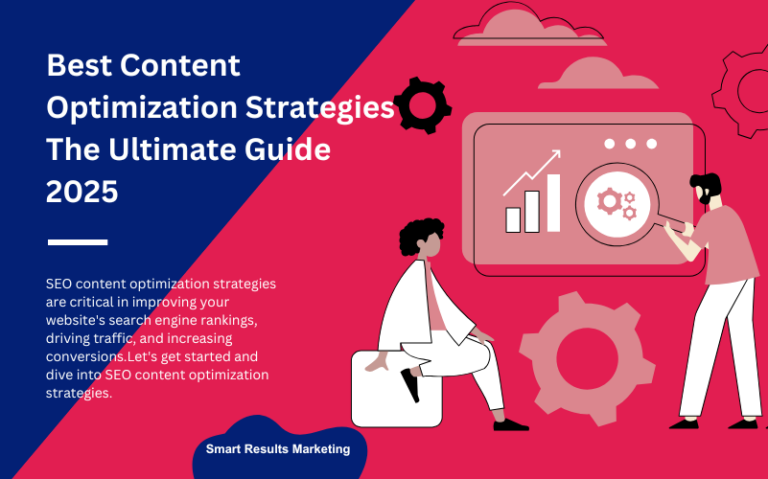Affiliate SEO Marketing: Your SEO Affiliate Marketing Guide (2025)

Ah, affiliate marketing—the art of turning your passion into profit.
And when you combine it with the enchanting forces of SEO, well, you’ve got yourself a winning formula!
Imagine this: You’ve created an amazing website for your affiliate marketing gig, filled with cool stuff that you think everyone should check out.
But here’s the catch—how do you make sure people can actually find your site among all the others out there?
That’s where the power of SEO comes in!
Now, I know what you’re thinking: “Can I really do all this SEO stuff by myself?”
Absolutely!
You don’t need to be a genius to understand and use SEO. What you need is patience, resilience and consistency for success.
I’ll be here to guide you every step of the way, and together we’ll make sure your website stands out in the online crowd.
Ready to make your website shine and attract lots of visitors?
Say AYE! Let’s jump right in.
What is SEO Affiliate Marketing?
SEO affiliate marketing is all about attracting organic traffic, which means visitors who genuinely want to explore what you have to offer.
Unlike paid advertising, which can be costly, organic traffic is like a gift that keeps on giving.
By implementing an effective SEO strategy, you can create a consistent flow of visitors who are highly inclined to become loyal customers, ultimately boosting your affiliate sales in the process.
And here’s a little insider tip: consider joining an affiliate network or program that offers SEO tools and resources.
For example, the SEO PowerSuite affiliate program provides valuable insights and software to help you optimize your website and track your progress.
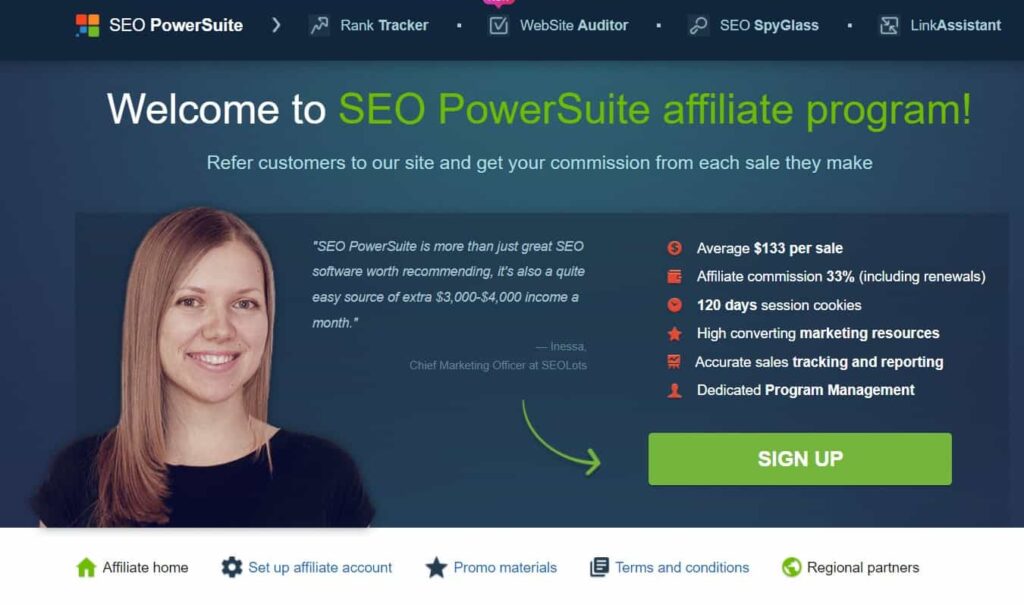
It’s like having a powerful sidekick on your affiliate marketing adventure!
Reasons You Need to Know about SEO Affiliate Marketing
First off, SEO helps you get noticed in the vast sea of websites.
More potential customers checking out your site and clicking on your affiliate links!
When more people find your site through search engines, it’s like opening the floodgates to affiliate sales.
It’s like having a virtual army of customers eager to buy what you’re promoting. Cha-ching!
With targeted keywords and quality backlinks, you show search engines that you’re the real deal.
It’s like telling them, “Hey, my site is legit and worth checking out!” And trust me, they listen.
Now, here’s the icing on the cake: SEO brings you long-term results.
Unlike those paid ads that disappear as soon as your budget runs dry, SEO keeps on giving.
It’s like having a steady stream of visitors flowing to yoptour site, even while you sleep.
And here’s the best part: SEO is budget-friendly!
You don’t need a massive advertising budget to get in on the action.
With a little time, effort, and clever optimization, you can achieve great results without breaking the bank.
It’ll boost your visibility, skyrocket your affiliate sales, and make you stand out from the competition.
It’s like having a secret weapon in your affiliate marketing arsenal.
Key Strategies for Successfully SEO Affiliate Marketing
1- Keyword Research:
So, let’s break it down.
Keyword research is the first step in your SEO affiliate marketing journey.
You want to find those long-tail keywords that have a decent search volume but aren’t too competitive.
These keywords are like little treasures that people are searching for, and by using them strategically in your content, you can increase your chances of ranking higher in Google search results.
Now, you might be wondering, “How do I find these magical keywords?” Well, fear not!
There are handy keyword research tools available that can help you uncover those hidden gems.
Tools like Google Keyword Planner, SEMrush, or Ahrefs can help you find relevant keywords.
These tools provide valuable insights into search volume, competition, and related keywords, giving you the knowledge you need to make informed decisions.
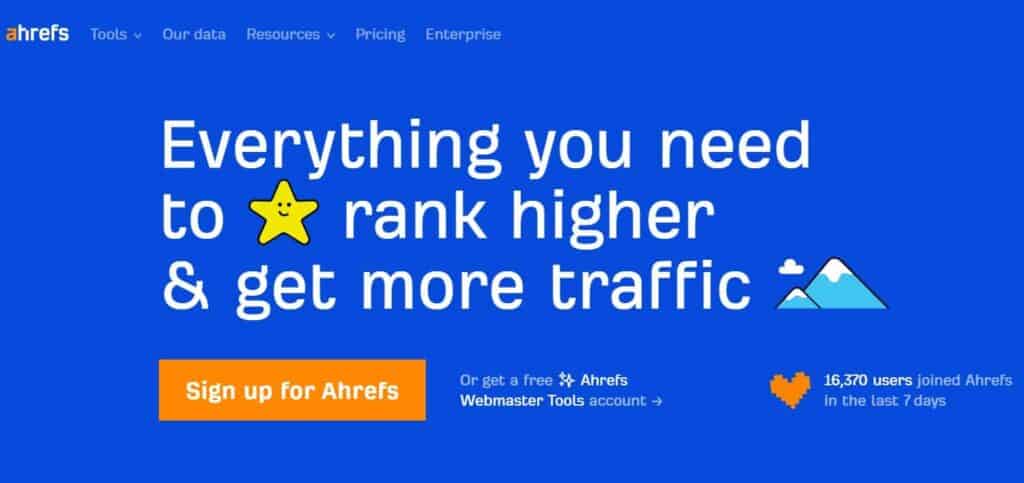
Once you have your keywords in hand, it’s time to sprinkle them throughout your affiliate website.
From your captivating blog posts to your product descriptions, incorporating these target keywords naturally will signal to search engines that your site is relevant to people’s queries.
And the more relevant you are, the higher you’ll rank!
To effectively target your audience, thorough keyword research is essential.
Here’s how you can do it:
TIPS:
- Analyze search volume and competition: Look for keywords with a decent search volume and relatively low competition.
High search volume indicates a popular keyword, while low competition means you have a better chance of ranking well for it.
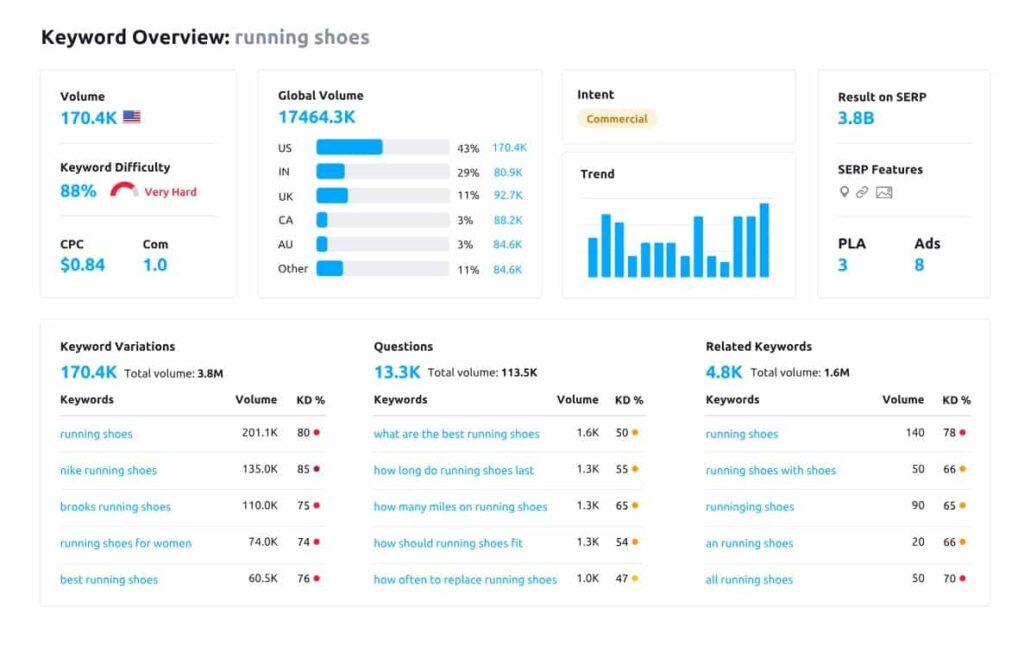
- Long-tail keywords: Focus on long-tail keywords that reflect user intent and have a higher chance of conversion.
For example, “best anti-ageing cream for sensitive skin” is more specific than “anti-ageing cream” and likely to attract users actively looking for a solution.
2- High-Quality Content Creation:
When it comes to creating compelling content for your affiliate marketing site, think of it as telling a captivating story that keeps your audience hooked from beginning to end.
First, put yourself in the shoes of your target audience.
- What are their pain points?
- What information or solutions are they seeking?
By understanding their needs and desires, you can craft content that resonates deeply with them.
Example:
Imagine you’re promoting fitness equipment.
Instead of just listing the features of each item, go beyond the surface.
- Share personal anecdotes about how these tools have transformed your own fitness journey.
- Include practical tips and expert advice.
- Share workout routines, nutrition tips, and motivational quotes to keep your readers inspired and motivated.
Make it a one-stop destination where they can find everything they need to embark on their fitness journey.
And hey, let’s not forget the power of visual content.
Include high-quality images or even videos showcasing the equipment in action.
Seeing is believing, right?
When your audience can visualize themselves using these tools and experiencing the benefits firsthand, they’ll be more inclined to make a purchase through your affiliate links.

Remember, the key is to provide value.
Educate, entertain, and empower your audience through your content.
Be authentic, share your personal experiences, and let your passion shine through.
When your audience feels a genuine connection with you and trusts your recommendations, they’ll be more likely to take action and click on those affiliate links.
Pro tip: Don’t be afraid to inject some humour into your content!
A well-placed joke or witty remark can make your readers chuckle and remember your site.
It adds a touch of personality and makes your content more relatable.
Just be sure to keep it appropriate and relevant to your niche.
3. Link-Building Magic:
Building quality backlinks from reputable websites is like building a network of digital endorsements.
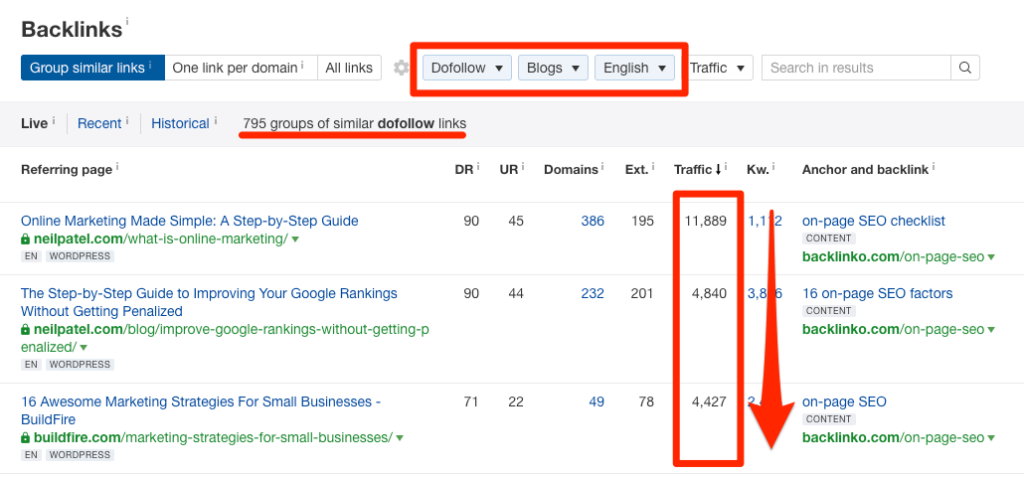
Imagine this: you’ve created a captivating blog post that reveals the extraordinary benefits of a specific vitamin supplement.
It’s like a hidden gem of knowledge waiting to be discovered by those seeking a healthier, more vibrant life.
But how do you ensure that it reaches the right eyes and captures the attention it deserves?
That’s where the power of building quality backlinks comes into play.
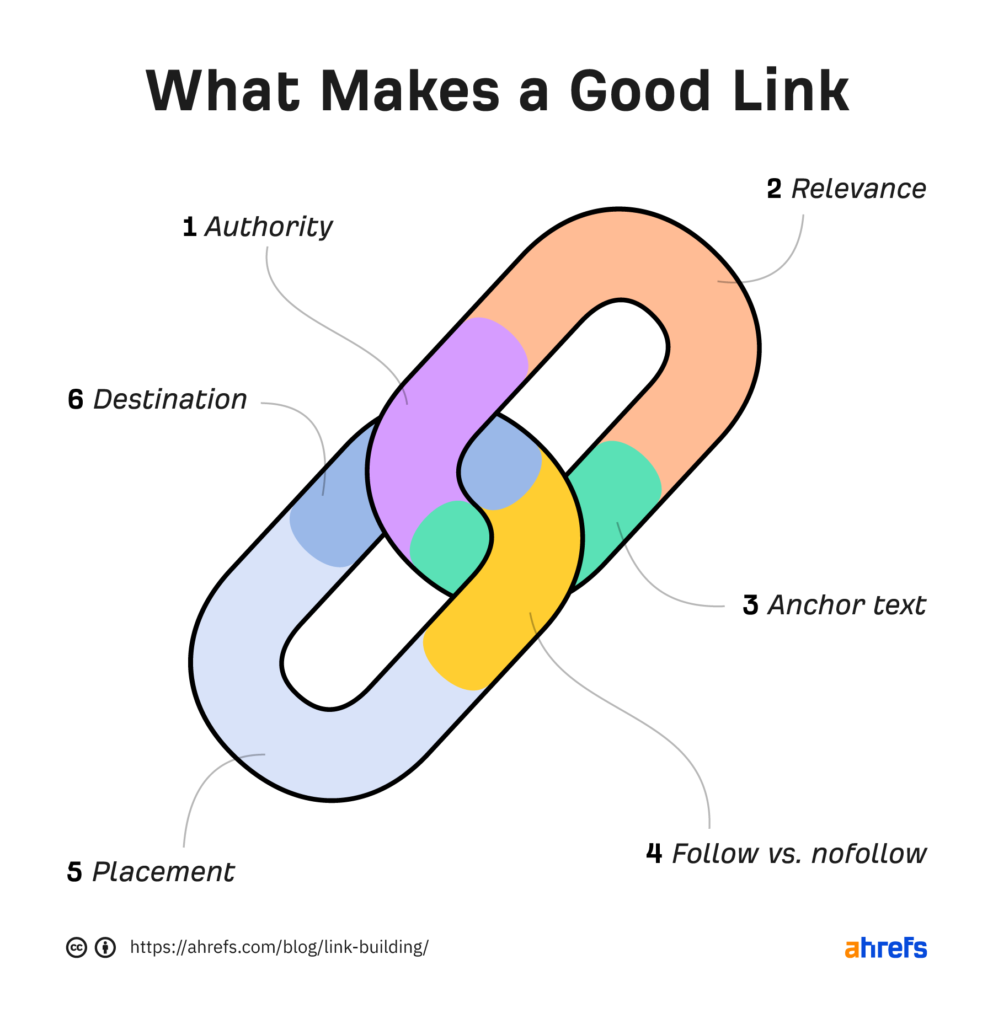
Think of reputable websites as influential friends who can vouch for the awesomeness of your content.
They act as digital endorsements that signal to search engines, “Hey, this content is legit and worth checking out!”
Imagine reaching out to health and wellness influencers or experts who hold sway in the digital world.
Share your valuable blog post with them and ask if they’d be interested in featuring or linking to it.
When these authoritative websites link back to your content, it’s like receiving a stamp of approval from the experts.
Search engines notice this vote of confidence and reward your site with increased credibility and visibility.
It’s as if you have influential friends shouting from the digital mountaintops, “This site is amazing, you’ve got to check it out!”
A Network of Endorsements
The beauty of building backlinks in this way is that it establishes a network of digital endorsements.
Each reputable website that links to your content adds another layer of trust and authority.
It’s like weaving a web of connections that extends your reach and amplifies your message to a wider audience.
As your content gains more backlinks from authoritative sources, search engines begin to take notice.
Your site climbs the ranks of search results, attracting organic traffic from people searching for the very information you provide.
Reach out to influencers, experts, and authoritative websites in your niche.
Share your valuable content with them and let them become your digital endorsers.
As these backlinks accumulate, watch as your site’s credibility and visibility soar to new heights.
Pro tip:
Remember, building quality backlinks is not just about quantity; it’s about forging meaningful connections and nurturing relationships.
Approach each outreach with sincerity, respect, and a genuine desire to collaborate.
By building strong bonds with influencers and experts in your industry, you not only gain backlinks but also open doors to future partnerships, collaborations, and even more opportunities to grow your affiliate site.
4- On-Page Optimization: Optimize Like a Pro:
Optimizing your site for search engines is crucial for better visibility.
Utilize those keywords we found earlier and incorporate them strategically into your page titles, headings, and meta descriptions.
Yoast SEO and Rankmath are two of the great plugins that you can add to your site tool kit.
Here’s what you should focus on:
- Title tags: Optimize your title tags by incorporating your target keywords naturally.
For example, if you’re promoting a digital marketing course, a suitable title tag could be “Master Digital Marketing: Best Online Courses for 2024.”
The key here is to strike a balance between optimization and readability.
Make it intriguing and relevant, leaving no doubt that your page holds the answers they seek.
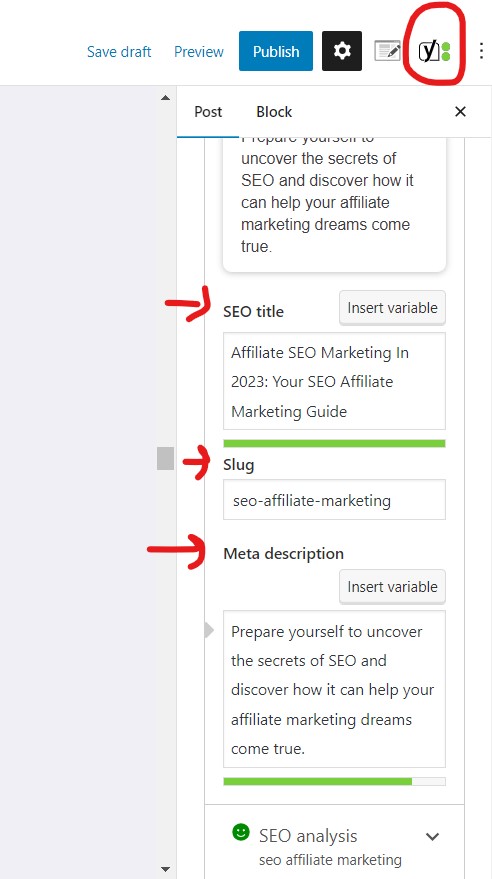
- Meta descriptions: Write compelling meta descriptions that entice users to click through to your content.
Include your target keywords naturally while describing the benefits or unique selling points of the affiliate product.
- Headings: Structure your content with proper headings (H1, H2, H3, etc.). Incorporate relevant keywords in your headings to improve readability and SEO.
Think of them as signposts within your content, guiding both search engines and readers through the magical journey you’ve crafted.
Add your keywords naturally into the headings, making them informative and engaging
For example, if you’re writing an article about the benefits of a specific supplement, use headings like “The Science Behind [Supplement Name]” or “How [Supplement Name] Can Improve Your Health.”
- URL structure: Optimize your URL structure to include relevant keywords.
For instance, instead of using a generic URL like “yourwebsite.com/product123,” use a more descriptive and keyword-rich URL like “yourwebsite.com/best-anti-aging-cream.”
Optimization is an ongoing journey.
Stay vigilant and adapt to the ever-changing landscape of search engine algorithms.
Regularly review and refine your on-page SEO strategy to keep your website at the forefront of search results.
5-Utilize Internal Linking:
Think of internal linking as a clever navigation system within your website.
By strategically linking relevant pages together, you create a roadmap for both search engines and visitors to explore and discover more valuable content.
It’s like guiding them through a captivating journey within your website’s magical realm.
As you create new blog posts or pages, look for opportunities to link back to existing content on your site.
Let’s say you’ve written a blog post about the top 10 healthy recipes.
Within that post, you can link to other related articles, such as a guide on meal planning or an in-depth post about the nutritional benefits of specific ingredients.
By interconnecting your content, you create a network of knowledge and provide a seamless experience for your visitors.
Why is internal linking so powerful?
Well, it serves two main purposes.
Firstly, it helps search engines understand the structure and relevance of your website.
When they encounter internal links, they follow them to discover more content and gain a deeper understanding of your site’s context.
This can ultimately lead to higher rankings in search results.
Secondly, internal linking improves the user experience.
Imagine a visitor reading one of your blog posts and finding a link to a related topic they’re interested in.
With just a click, they can delve deeper into the subject and find more valuable information.
This keeps them engaged and encourages them to spend more time on your site, reducing bounce rates and increasing the chances of conversion.
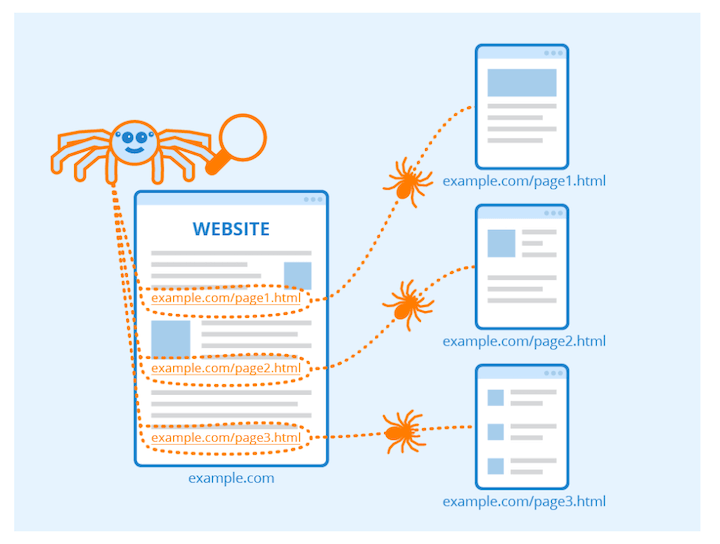
PRO TIP:
To enhance your internal linking strategy even further: make sure to use descriptive anchor text.
Instead of generic phrases like “click here” or “learn more,” use keywords or phrases that accurately describe the content you’re linking to.
This not only helps search engines understand the relevance of the linked page but also entices visitors to click through and explore further.
Be strategic and ensure the links are relevant and helpful to the user’s journey.
6-Mobile Optimization:
A responsive design is the key to success here.
By adopting a responsive layout, your website will automatically adjust its appearance and functionality based on the user’s device.
Whether your audience is using a smartphone, tablet, or any other mobile device, they will experience a seamless and visually pleasing interface.
Next, pay special attention to page load speed.
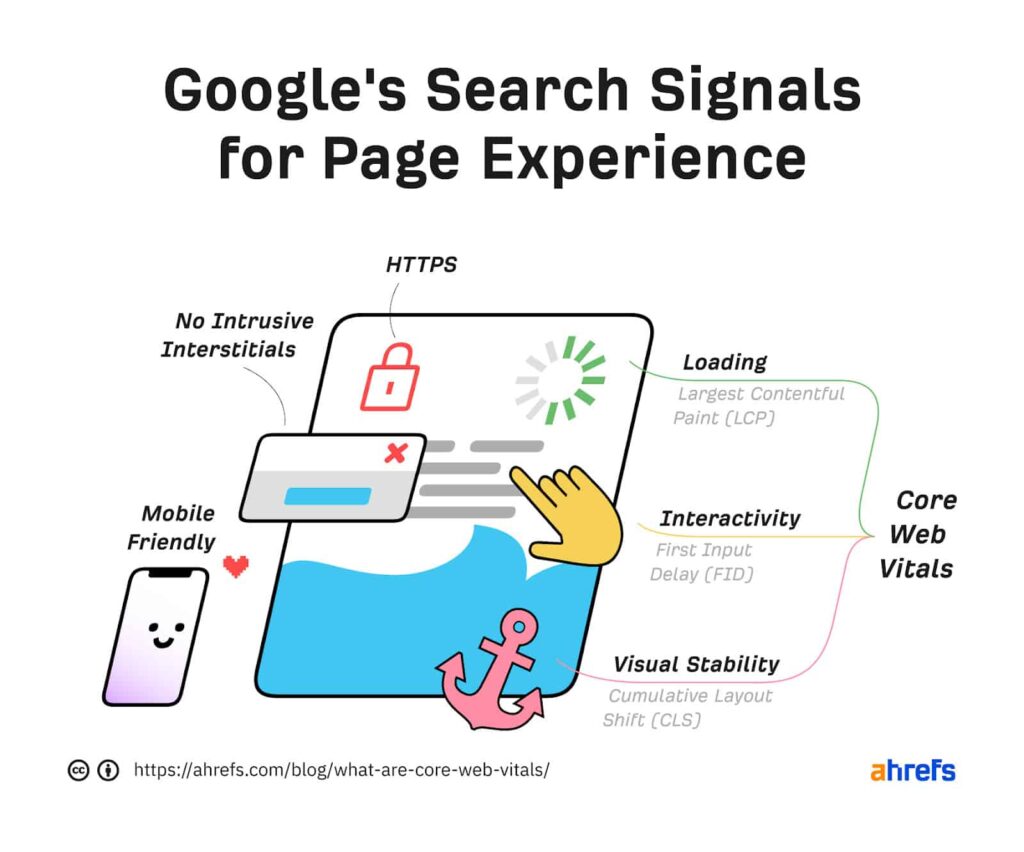
Mobile users are often on the go, seeking quick answers and immediate results.
If your website takes ages to load on their mobile devices, they’ll likely abandon ship and sail towards a faster competitor.
Optimize your images, minify your code, and leverage caching techniques to ensure swift loading times and keep your audience captivated.
Another crucial aspect of mobile optimization is designing for touch interactions.
Mobile users rely on their fingers to navigate through your website.
Make sure your buttons, menus, and links are large enough and well-spaced to avoid frustrating misclicks.
By providing a user-friendly touch experience, you’ll keep your visitors engaged and increase the chances of affiliate conversions.
PRO TIP:
Don’t forget about the power of mobile search.
Mobile users often turn to search engines to find products, services, or information.
Ensure your website is easily discoverable by optimizing your content for mobile search.
Conduct keyword research specifically for mobile users and create compelling, mobile-optimized meta tags and descriptions.
By aligning your SEO efforts with mobile search, you’ll attract more organic traffic and increase your chances of affiliate conversions.
In summary:
- Responsive design: Ensure your website has a responsive design that adapts seamlessly to different screen sizes and resolutions.
Test your website on various devices and browsers to ensure a consistent and user-friendly experience.
- Mobile-friendly navigation: Simplify your website’s navigation for mobile users.
Use a clear and easy-to-access menu, minimize the use of dropdowns, and consider implementing a search bar for quicker access to specific content.
- Mobile page speed: Optimize your website’s loading speed for mobile devices.
Compress images, minify CSS and JavaScript files, and leverage caching techniques to improve page load times.
7-Social Media Integration:

Leverage social media platforms to amplify your affiliate marketing efforts. Here are alternative ways to do it:
- Influencer partnerships: Collaborate with influencers in your niche and have them promote your affiliate products through their social media channels.
For example, an influencer in the fashion industry could showcase an outfit and share a discount code for the clothing items they’re wearing on Instagram.
- User-generated content campaigns: Encourage your audience to create and share content featuring your affiliate products.
Run contests or giveaways where users can submit their photos or videos using the products, and reward them for their participation.
- Live video demonstrations: Host live video sessions on platforms like Instagram or Facebook, demonstrating how to use or benefit from the affiliate products.
Engage with viewers in real time, answer their questions, and include affiliate links in the video description or comments.
Remember, these alternative examples provide additional options to consider.
Choose the strategies that align best with your niche, audience, and available resources.
Frequently Asked Questions
What is affiliate marketing and how does it work?
At its core, affiliate marketing is a mutually beneficial partnership between you (the affiliate marketer) and a company or brand (the affiliate program).
It’s like having a fairy godmother grant you the power to promote products or services that align with your interests and expertise, all while earning a commission for each successful referral or sale.
So, how does it all come together? Let me break it down for you.
First, you’ll need to set up your own website or affiliate site—a digital stage where your magical marketing performances will take place.
This site will be the platform from which you’ll captivate your audience and guide them towards the products or services you’re promoting.
Next comes keyword research—an essential step in your SEO affiliate marketing journey.
By delving into the world of search engine optimization, you’ll uncover the most relevant and valuable keywords that align with your niche and resonate with your target audience.
These keywords will be the spells you cast to attract the attention of search engines and draw organic traffic to your affiliate site.
Once armed with your keywords, it’s time to weave them seamlessly into your content.
Your goal is to create compelling content that not only educates and entertains but also entices your audience to take action.
With each piece of content, you’ll strategically:
1-Incorporate your keywords to optimize your visibility on search engines (SEO)
2-Attract the eyes of potential customers (human readers)
Affiliate Program
Now, let’s talk about the affiliate program—the bridge that connects you to the enchanting world of earning commissions.
You’ll seek out and join affiliate programs that align with your niche and offer products or services that resonate with your audience.
Once you’re accepted into a program, you’ll receive unique affiliate links that you’ll sprinkle throughout your content like hidden treasures.
These links are your ticket to earning commissions when your audience clicks on them and makes a purchase.
As an affiliate marketer, your success lies in the power of persuasion and the trust you build with your audience.
Your authentic voice, expertise, and personal experiences will be the ingredients that breathe life into your marketing efforts.
By genuinely recommending products or services that you believe in, you’ll establish credibility and forge a strong bond with your audience, making them more likely to follow your recommendations and become your loyal customers.
Is affiliate marketing worth it? Is affiliate marketing legit?
Absolutely! I understand your concerns about the legitimacy and worth of affiliate marketing.
Let me assure you that affiliate marketing is indeed a legitimate and valuable strategy in the world of digital marketing.
Affiliate marketing operates on the principles of mutual benefit and transparency.
As an affiliate marketer, you partner with reputable companies through affiliate programs, promoting their products or services.
When your audience makes a purchase through your affiliate links, you earn a commission.
These programs are designed to track and reward your efforts, ensuring fairness and transparency.
Now, let’s address the worthiness of affiliate marketing.
By leveraging SEO techniques, conducting keyword research, and building authentic connections with your audience, affiliate marketing offers significant potential for success.
It allows you to reach a targeted audience actively searching for solutions in your niche, increasing your chances of driving traffic and earning commissions.
However, it’s important to remember that affiliate marketing requires effort, dedication, and continuous learning.
It’s not a get-rich-quick scheme. With the right mindset, persistence, and a commitment to providing value, affiliate marketing can become a profitable income stream.
So, rest assured that affiliate marketing is a legitimate and valuable strategy.
Embrace the possibilities, stay committed to your goals, and let the rewards of affiliate marketing unfold.
With determination and a strategic approach, you can achieve remarkable results in the world of affiliate marketing.
Now, go forth with confidence, knowing that the potential for success is real and within your reach.
May your affiliate marketing journey be filled with growth, fulfilment, and the sweet taste of well-deserved commissions.
How to start affiliate marketing?
If you’re eager to dive in and start your own affiliate marketing journey, I’ve got you covered. Let’s walk through the steps to get you started on the right track.
First things first, it’s important to find your niche.
Think about your interests, passions, and areas of expertise. What topics or products resonate with you?
Choosing a niche that aligns with your interests will make the whole process more enjoyable and authentic.
Next, it’s time for some good ol’ market research.
Identify your target audience and understand their needs, preferences, and pain points.
This knowledge will help you tailor your content and promotions to effectively connect with your audience.
Once you have a niche and target audience in mind, it’s time to hunt for affiliate programs.
Look for reputable companies that offer affiliate programs in your niche.
These programs provide you with unique affiliate links that you can use to track your referrals and earn commissions.
Content Creation
Now, let’s talk about content creation.
Your website or blog will be the heart of your affiliate marketing business.
Create valuable, engaging, and informative content that attracts and engages your audience.
Focus on providing solutions, answering questions, and showcasing the benefits of the products or services you promote.
Don’t forget about search engine optimization (SEO).
Conduct keyword research and strategically incorporate those keywords into your content to improve your website’s visibility on search engines.
This will help you attract organic traffic and increase your chances of earning commissions.
Promotion time! Leverage various channels to drive traffic to your website.
This could include social media platforms, email marketing, guest blogging, or even paid advertising.
Experiment and find what works best for you and your audience.
As you start generating traffic and referrals, keep a close eye on your analytics.
Monitor your website’s performance, track conversions, and make data-driven decisions to optimize your strategies and maximize your results.
Last but not least, always prioritize building trust with your audience.
Be authentic, and transparent, and provide honest recommendations.
Your audience’s trust is the key to long-term success in affiliate marketing.
How to make money with affiliate marketing?
When it comes to making money with affiliate marketing, there are a few key steps to follow:
- Choose a niche you’re passionate about: Select a niche that aligns with your interests and expertise. This will make it easier for you to create compelling content and connect with your audience on a deeper level.
- Create valuable content that resonates with your audience: Focus on providing high-quality content that solves problems, answers questions, and offers valuable insights. By offering genuine value, you’ll build trust with your audience and increase the likelihood of them making purchases through your affiliate links.
- Drive targeted traffic to your website or blog: Utilize various marketing channels to attract visitors to your site. Optimize your content for search engines through search engine optimization (SEO) techniques, engage with your audience on social media platforms, and leverage email marketing to nurture and convert leads.
- Select reputable affiliate programs with attractive commissions: Partner with affiliate programs that offer quality products or services and fair commission rates. Research different programs, read reviews, and choose those that align with your niche and audience’s needs.
- Diversify your income streams: Consider exploring different affiliate programs, testing various products or services, and even creating your own digital products or courses. Diversifying your income streams can help you maximize your earnings potential and protect against fluctuations in specific markets.
- Build relationships and network with other affiliate marketers: Connect with fellow affiliate marketers to share insights, collaborate on joint ventures, and support each other’s growth. Building relationships within the affiliate marketing community can open doors to new opportunities and valuable partnerships.
Be patient, persistent, and adaptable:
Affiliate marketing success doesn’t happen overnight. It takes time to build an audience, establish trust, and generate significant income.
Stay committed to your goals, be persistent in your efforts, and adapt to changes in the industry.
Learn from both successes and setbacks to continuously refine your strategies.
With the right mindset and consistent effort, you can turn your affiliate marketing endeavours into a profitable venture.
Wrap-Up – Conclusion
So, there you have it – your comprehensive guide to Affiliate SEO Marketing in 2025!
By implementing the strategies and techniques outlined in this guide, you’ll be well-equipped to navigate the world of affiliate marketing with a focus on search engine optimization.
Stay up to date with the latest SEO trends and algorithm updates, and always keep the needs and interests of your audience at the forefront.
With passion, dedication, and a sprinkle of creativity, you’ll be on your way to achieving higher rankings, increased organic traffic, and ultimately, more conversions and revenue.
So, go forth, take action, and embrace the power of SEO in your affiliate marketing endeavours.
Happy optimizing and may your affiliate ventures flourish!

